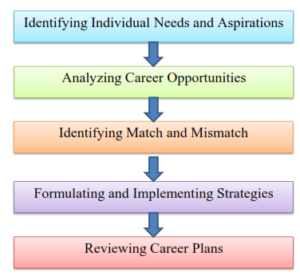Objectives of Career Planning
i. To attract and retain the right type of persons in the organization.
ii.To map out careers of employees suitable to their ability, and their willingness to be trained and developed for higher positions.
iii.To ensure better use of human resources through more satisfied and productive employees.
iv.To have a more stable workforce by reducing labour turnover and absenteeism.
v.To increasingly utilise the managerial talent available at all levels within the organisation.
vi.To improve employee morale and motivation by matching skills to job requirements and by providing opportunities for promotion.
vii.To ensure that promising persons get experiences that will equip them to reach responsibility for which they are able.
viii.To provide guidance and encourage employees to fulfil their potentials.
ix.To achieve higher productivity and organisational development.
Important Terminology used in Career Planning
Career
All jobs that are held during one’s working life
Career Development
It is the process of identifying career goals and establishing the means of making them a reality.
Career Management
The process of designing and implementing plans to enable the organization to satisfy employee’s needs and allow individuals to achieve their career goals.
Career Plateau
It is a position from which someone is unlikely to move to a higher level of work responsibility.
Career Progression
Making progress in one’s career through a series of right moves.
Career Counseling
It is the process of helping individuals sort out career issues and make career decisions.
Career Path
Career path refers to the systematic and deliberate advancement made by an individual in his career in the entire work life. It indicates the way in which one’s career has progressed and is determined by various factors such as individual’s knowledge, skills, ability and the opportunities actually available.
Career Anchors
They are distinct patterns of self perceived talents, attitudes, motives and values that guide and stabilize a person’s career after several years of real world experience and feedback.
Career Goals
Future positions one tries to reach as part of a career.
Career Cycle
The stages through which a person’s career evolves.
Career Plateau
It is a position from which someone is unlikely to move to a higher level of work responsibility.
Career Cluster
Career clusters refers to the categorization of different occupations. Jobs of similar nature are usually brought together under a career cluster.
Career Stages
Most people go through five stages in their career:
1.Exploration
Very early in life of a person, parents begin to explore career choices. The exploration period ends for most of us in mid-twenties as we make the transition from college to work. This stage involves self-analysis and exploration of different types of available jobs.
2.Establishment
This stage begins with search for work and includes the first job, learning it and being accepted by peers. It is also marked by mistakes. and good performance. Employment sought in this stage is guided by what was learnt during exploration.
3.Mid Career
At this point in a career people may move up or reasses their priorities.
4.Late Career
Those who continue to grow through the mid-career stage, this stage is pleasant. One can enjoy success and respect from younger employees. Those who have stagnated. they realise that they cannot change the world. One starts looking forward to retirement. due to career plateauing.
5.Decline
The final stage is difficult for everyone. After several decades of continuous achievements, the time has come for retirement.
Process of Career Planning
The career planning process involves the assessment of the factors influencing the career options in order to make an informed choice about career goals and its execution strategy. The steps involved in career planning process are:
1.Identification of Needs and Aspirations of Individual
Most individuals do not have a clear idea about their career aspirations, anchors and goals. The human resource professionals, therefore, help an employee by providing information about kind of work that would suit the employee most, taking his skills, experience, and aptitude into account. Human resource inventory will reveal the age, qualifications, experience and aptitude of present employees. Appraisal of employees is then carried out to identify the employees having the necessary potential for climbing up the ladder and are willing to be promoted up to higher responsibilities.
2.Analyzing Career Opportunities
The organizational set up, future plans and career system of the employees are analyzed to identify the career opportunities available within it. Career paths can be determined for each position. It is also necessary to analyze career demands in terms of knowledge, skills, experience. aptitude, etc. Long-term and short term career goals can be defined after relating specific jobs to different career opportunities. At a particular level, there may be young direct recruits as well as older persons who have risen to the level through promotions. The former aspire for quick career progress due to their better education and training. The latter cannot be expected to move up very high due to limited professional education. Therefore, promotions and direct recruitment at every level must be so planned as to ensure a fair share to each group. This is called age balance in career paths.


